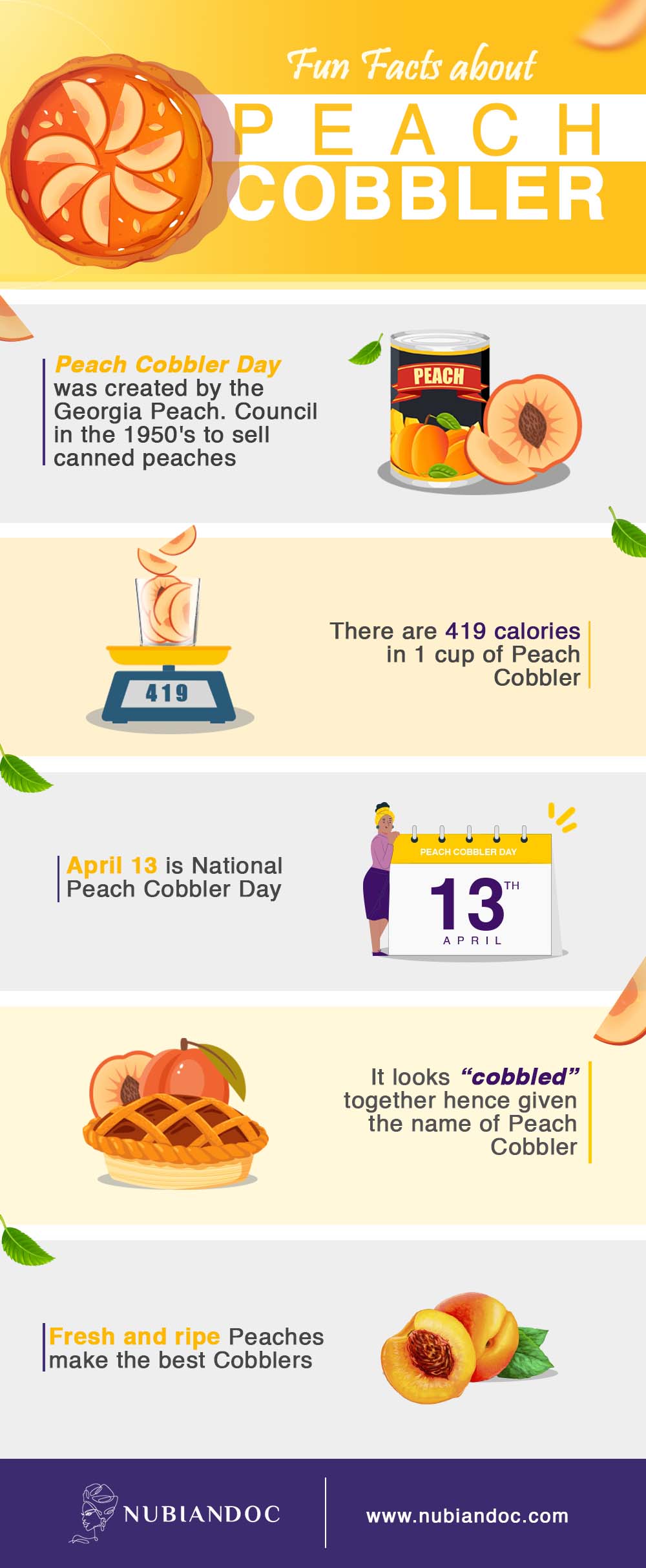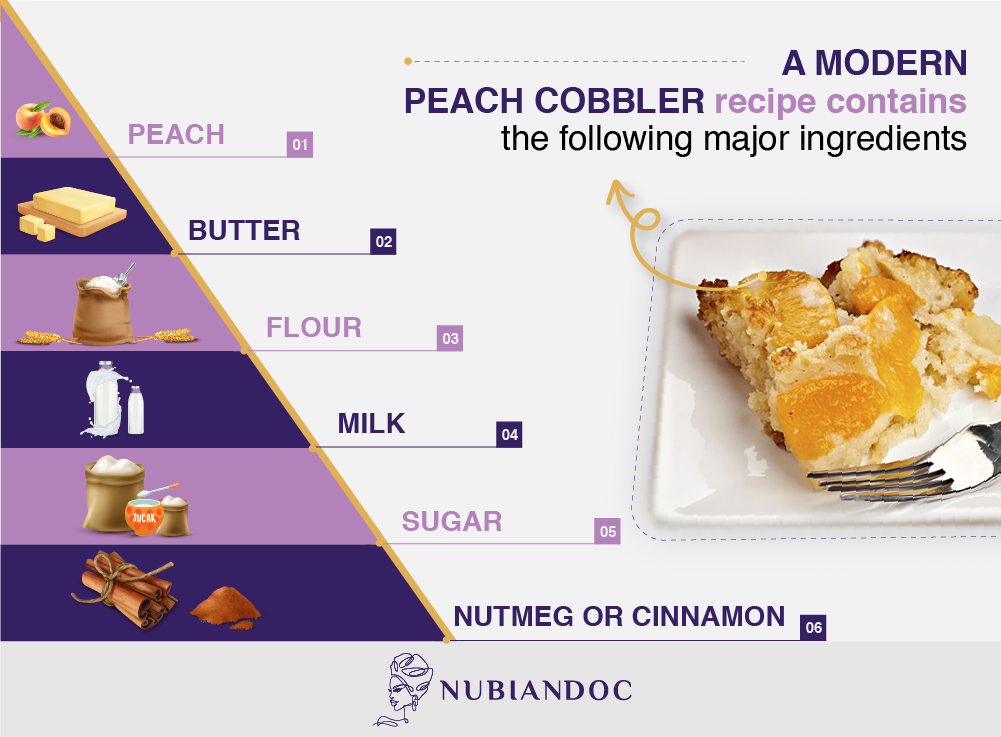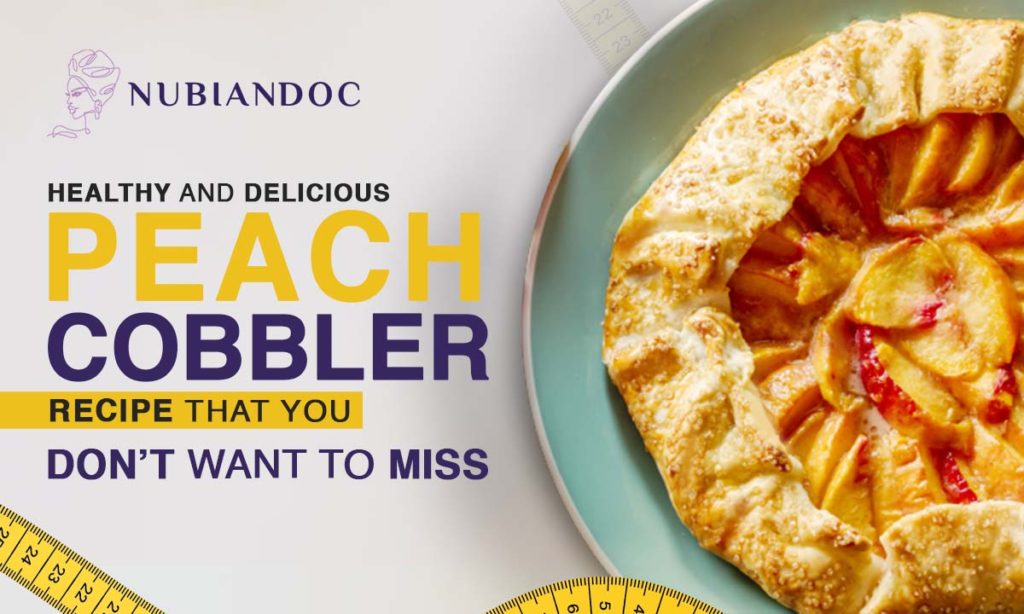Peach Cobbler Health Benefits, Calories & Nutritional Value
Healthy Peach Cobbler? | Types of Cobblers | Health Benefits of Peaches | Healthier Recipe | Ingredients to Keep & Avoid | Bottom Line
Doesn’t it seem unfair how hard it is for people with a sweet tooth to eliminate dessert from their diet completely? Well, it does to me, and it hit me more when last week, I felt this craving for a warm, comforting dessert to hug me from the inside of my stomach, and all I could think of was… Peach Cobbler! But as soon as I realized how much sugar and butter would go in it, I felt extremely disheartened.
I was far too deep into my weight-loss journey to just be careless with about 300 calories for momentous happiness. The rage I felt was real, and I said to myself that it isn’t my mistake. I am born with a sweet tooth, but I can do something to bring my craving and discipline to a middle point. And I set on to preparing my first ever healthy Peach Cobbler but not the traditional way.
In this article, I will share what I learned while creating a dessert that satisfies the taste buds but doesn’t fiddle with your low–calorie diet plans. Read on as I discuss more health benefits of Peaches, a little history, fun facts and lastly, the revolutionary recipe of Peach Cobbler with about half the calorie count!
Can Peach Cobbler be made healthy?
Peach Cobbler is a simple dessert with peach as its main ingredient, topped with a crispy crust. If you have ever had an original Peach Cobbler, I doubt it isn’t your favorite dessert. The only reason you might want to stay away from these bites of heaven, can be the unhealthy label that comes with it. But it is not the only soul food that is labelled as unhealthy and avoided by many. Other soul foods like Okra, Peach Cobbler too can be made healthy while maintaining the same amazing taste.
Is Peach Cobbler even worth eating? The answer is a big fat YES or a big fat NO, depending upon how you prepare it. Soul food is often deemed as an unhealthy cuisine, and rightfully so. With organ meats and fatty cuts being its major component, many may stir away from the cuisine due to dieting purposes. A good peach Cobbler ends this issue and even allows vegans to enjoy this rightfully celebrated cuisine.
A Little History
The Origin of Peach Cobbler
Ironically, Peach Cobbler came into being out of dislike of fresh fruit. The English during the 1500s weren’t particularly fond of eating fresh fruit so they would cook their fruit with sugar. The first Cobbler perhaps came into being by placing sliced peaches at the bottom of the pot and covered with a layer of biscuit. The modern day Cobbler however is made by sandwiching the peaches in between layers of dough.
Some Facts about Peach Cobbler
According to The Oxford Companion To Food, the name seems to have first appeared in print in 1864, when an article in the Yale Literary Magazine listed it (in quotation marks, implying that it was not then a fully established term) with tea, coffee, and pies as things to be given up during ‘training’. That author gave brown in lower case and Betty in upper case: and, in default of evidence to the contrary, it seems best to go along with the view that Betty is here a proper name.
According to The American History Cookbook by Mark H. Zanger, as reported by What’s Cooking America, Brown Betty (1890) – This recipe was part of the winning essay for the $500 American Public health Association Lomb prize on practical, Sanitary, and Economic Cooking Adapted to persons of Moderate and Small Means, which became a book of the same title by Mrs. Mary Hinman Abel. It was part of a series of menus to feed a family on thirteen cents a day. Mrs. Abel may have carried the recipe into use in the New England Kitchen, an experimental Boston restaurant aimed at “improving” the food choices of the poor.

Types of Cobblers
Cobbler – An American deep-dish fruit pie with a thick crust (usually a biscuit crust) and a fruit filling. Some forms of Cobblers are wrapped in the crust, while others have a crumb topping.
Crumbles – Crumbles are more like the primitive kind. They are baked with the fruit mixture on the bottom with a crumb topping. The crumb topping can be made with flour, nuts, bread crumbs, cookie or graham cracker crumbs, or even breakfast cereal. A Crumble is the British version of the American Crisp.
Brown Betty – A Brown Betty consist of a fruit filling baked between layers of buttered crumbs. Betty was a famous baked pudding made during colonial times in America.
This table shows the nutrients that one cup serving of Peach Cobbler contains:
| Nutrients | Weight | Daily Value |
| Total Fat | 10.05g | 13% |
| Cholesterol | 2mg | 1% |
| Sodium | 328mg | 14% |
| Total Carbohydrate | 79.53g | 29% |
| Protein | 5.19g | – |
| Calcium | 137mg | 11% |
| Iron | 2mg | 11% |
| Potassium | 312mg | 7% |
| Vitamin A | 28mcg | 3% |
| Vitamin C | 6.7mg | 7% |
| Vitamin D | – | – |
Health Benefits of Peaches
Have you ever seen a fruit that offers no health benefits? No, right? Peaches are also one of the healthiest fruits that contain nothing but amazing nutrients, fibers, and innumerable health benefits.
The Amazing Nutrition
According to the USDA database, one medium-sized Peach holds the following nutrients:
Calories: 58
Protein: 1 gram
Fat: Less than 1 gram
Carbs: 14 grams
Fiber: 2 grams
Vitamin C: 17% of the Daily Value (DV)
Vitamin A: 10% of the DV
Potassium: 8% of the DV
Niacin: 6% of the DV
Vitamin E: 5% of the DV
Vitamin K: 5% of the DV
Copper: 5% of the DV
Manganese: 5% of the DV
Peaches are not only loaded with these amazing nutrients but with strong antioxidants too. These antioxidants are plants compounds that prevent oxidative damage and reduce cellular level stress. Keep in mind that the fresher the peach is the more antioxidants it contains.
According to a study, drinking fresh Peach juice will show its antioxidant action within 30 minutes of consumption in healthy men.
Better Digestion
You must be aware of the wonders that fiber can do for your digestive health. Peaches are loaded with fiber making them an effective tool to fight majority of digestive issues. Peaches contain soluble and insoluble fibers. The former provides food for beneficial bacteria in your gut and the later add bulk to your stool. Research clearly indicates that fiber in your food can help relieve issues like constipation.
Healthier Heart
Peaches can fight the risk factor of heart disease like high blood pressure and high cholesterol levels. Test tube studies show that peaches can reduce total cholesterol as well as the bad cholesterol (low-density lipoproteins). They can also reduce your blood pressure and triglyceride level, lowering the risk of heart disease even further.
Prevention of Cancers
The plant compounds in peaches can lower the risk of various types of cancer. The carotenoids and caffeic acid in the peach skin and flesh are stuffed with antioxidants. These antioxidants are proven to have strong anti-cancer properties.
Summary: Peach Cobblers are not only a divine desert but also loaded with nutrients, all thanks to the Peaches. Peaches can fulfil a whopping 12.33% of the daily requirement of vitamin C by an average person. It has numerous benefits for the heart, skin, digestion, eye sight, anemia etc. Apart from all those benefits, Peaches are surprisingly low in carbohydrates which make them an excellent choice for weight loss.

Peach Cobbler Recipe with Half the Calories
Serves 4-5
Calories ~200
Filling
1 ¼ pounds fresh peaches (3-4 large), peeled (if desired) and thinly sliced, or 4 cups sliced frozen peaches, thawed
¼ cup honey/artificial sweetener
1 tablespoon cornstarch
¼ teaspoon freshly grated lemon zest
1 tablespoon lemon juice
Pinch of salt
Crust
1 cup white whole-wheat flour
½ cup cornmeal
1 ½ teaspoons baking powder
¼ teaspoon baking soda
¼ teaspoon salt
1 large egg
½ cup buttermilk
¼ cup olive oil
½ teaspoon ground cinnamon
Directions:
Preheat oven to 375 degrees F.
Combine peaches, honey or sweetener, cornstarch, lemon zest, lemon juice and a pinch of salt in a large bowl; mix well. Transfer to a 9-inch shallow glass or ceramic baking dish.
Whisk flour, cornmeal, baking powder, baking soda and salt in a large bowl and mix well. Whisk egg, buttermilk and oil in a small bowl. Add the wet ingredients to the dry ingredients and stir to blend.
Evenly spoon the batter over top of the peach mixture. Sprinkle the cinnamon powder over the topping. Bake, until the peaches are bubbly, the topping is golden brown and a toothpick inserted in the center of the topping comes out clean, for 40 to 50 minutes. Let cool for about 20 minutes before serving.
Summary: Enjoy this sugar and butter free recipe even when you are on a diet. Because of the elimination of sugar and butter and a one layer of crust, you can lessen the calorie content to half of a regular pie.
What Ingredients to Keep and What to Avoid?
Peaches are one ingredient in a Peach Cobbler that you shouldn’t even think about replacing. They are loaded with nutrition and provide health benefits beyond just good nutrition. The best way to use peaches in a peach Cobbler is to blanch them with peel or bake them as is. The lesser you cook them, the more health benefits they will provide. Just make sure that you wash your peaches really well, so no chemical preservatives enter your body and cause an allergic reaction.
Sugar has the miraculous property to make everything ten times tastier. But this taste comes at the cost of your very precious health. So, when opting for a healthy Peach Cobbler recipe, the first thing you have to skip is sugar. You can easily replace it with any zero-calorie natural sweetener of your choice.
What sugar substitutes work best in this recipe?
There are multiple sugar alternatives you can use for this sugar-free dessert recipe. Our choice is honey because it goes well with Peaches. You can also use artificial sweeteners like Equal, Splenda, Stevia or even coconut sugar.
The Bottom Line: Peach Cobbler
If you have a sweet tooth like me but still want to lose weight, you should take my word and opt for this sugar and butter free Peach Cobbler recipe that might not have the goodness of sugar but will still give you that comfort you need on days you are craving for a good but healthy dessert. Peach Cobbler is a wonderful option when you want to enjoy the taste of dessert and also choose something that is beneficial for your health.
If you are a busy woman and need help in losing weight, head on to NubianDoc to learn about how you can lose weight at home with our famous 8 week plan. Get your eBook now.
How do I know if my peach cobbler is cooked?
The best indicator is that the filling should be bubbly around the sides, and the tops of the biscuits should be more deep amber than golden. Use a probe thermometer inserted in the center of the cobbler which should reach 200°F in the thickest part of the topping.
How long can I store peach cobbler for?
You can store leftover peach cobbler covered in a refrigerator for about 2 or 3 days. It will help keep the cobbler topping from getting too mushy.
What is the difference between a cobbler and a pie?
The biggest difference is that a cobbler is so easy to make (easier than pie!). While a pie is made with a bottom crust and often a top crust, the dough and the fruit filling cook together in a cobbler
Is Peach Cobbler supposed to be gooey?
The perfect cobbler has a gooey fruit center encrusted with a sweet breaded top layer. A runny cobbler usually means that the fruit used in the dish was extra juicy. You can correct the runny cobbler by adding a thickening agent.
How do you thicken peach cobbler?
Cook the fresh or frozen peaches down with some sugar, lemon juice, and cornstarch until bubbling. The cornstarch will thicken the juices so that your peach cobbler doesn't come out runny.


